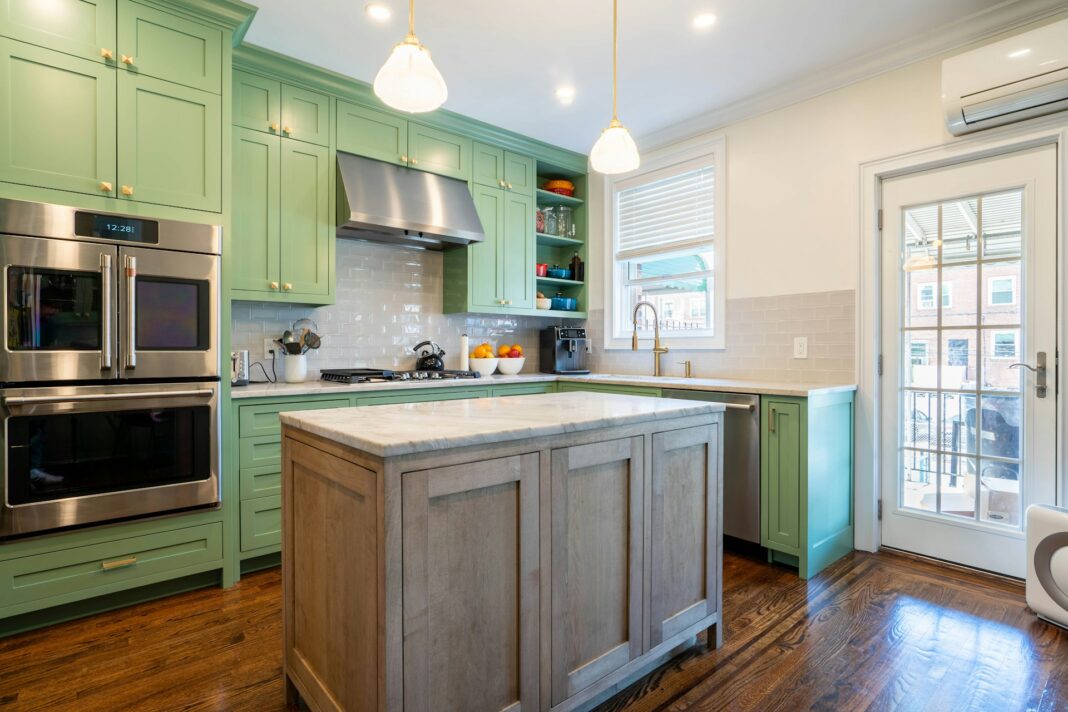Key Takeaways
- Embracing the transformative power of greenery in kitchen design.
- Incorporating plant life to elevate both aesthetics and air quality.
- Utilizing green elements like lighting and paint for a completely natural feel.
- Exploring innovative ways to blend functionality with eco-conscious design.
- Adopting biophilic design to enhance physical and mental well-being.
The Rise of Biophilic Design in Kitchens
In recent years, the concept of biophilic design has seen a meteoric rise, making its presence felt keenly in the heart of the home: the kitchen. Moving away from purely utilitarian spaces, there’s a growing trend among homeowners who are going green in a different way, bringing nature indoors, and seeking to create a serene and healthful environment that resonates with their innate love for natural elements.
Layers of Green: Embracing Varied Textures and Shades
Adding greenery to a kitchen goes beyond potted plants on the windowsill. With myriad textures and shades available in the plant kingdom, it’s possible to create a lush, layered look that entices the senses. From hanging ferns that cascade from shelves to aromatic herbs that double up as culinary essentials, one’s imagination is the only limit when greening a kitchen space. Engaging with diverse plant life transforms mundane tasks, going green differently, making every culinary endeavor a dance with nature’s beauty.
Creating a Green Haven with Houseplants
Introducing houseplants into the kitchen seamlessly blends aesthetics with health benefits. Beyond looking beautiful, plants like spider plants, aloe vera, and peace lilies work tirelessly to purify the air, making the kitchen a fresher and more invigorating space. With careful choice and placement, even the smallest kitchens can be transformed into verdant nooks that offer a tranquil retreat from the bustling world outside.
Utilizing Green Lighting for an Organic Ambience
Lighting is a crucial aspect of kitchen design, and green lighting options have the dual advantage of energy efficiency and gentle illumination that mimics the soft glow of the natural world. LED lights that replicate daylight can promote a healthier rhythm of life while saving energy. Adequately chosen lighting infuses the kitchen with a warmth that extends the sensation of a sunny garden indoors, creating an inviting and inspiring space for creativity in cooking.
The Allure and Impact of Green Paint
Color has a powerful impact on our emotions and well-being, and using green paint in the kitchen can calm and refresh the mind. The myriad hues available can evoke the feeling of a verdant forest or a soft, mossy knoll. When applied thoughtfully, green paint accentuates the natural feel of the space, further imprinting the theme of nature into the design of the kitchen.
Blending Form and Function with Eco-Conscious Materials
Harnessing the potential of eco-friendly materials is another approach to deepen the natural appeal of the kitchen while staying true to environmental values. Sustainable materials such as recycled glass countertops or bamboo cutting boards are durable and practical and pay homage to nature’s simplicity and integrity. Such material choices are testimony to a design philosophy that honors the environment without sacrificing style or substance.
Harmonizing Space with Integrated Planting Solutions
For those with limited kitchen space or who crave a more integrated approach, built-in planting solutions such as custom planter boxes or vertical gardens are a refreshing and innovative answer. These living installations bring dynamic energy to the kitchen, blurring the lines between the built and natural environments and offering a seamless way to cultivate various plants for visual enjoyment and culinary use.
Enhancing Livability with Biophilic Design Principles
At its core, biophilic design seeks not just to beautify a space but to enhance the overall livability of our homes. By fostering a close connection with nature in the kitchen, this design ethos provides a profound sense of well-being, reduces stress, and improves cognitive function. It’s a comprehensive approach that seeks to place human and environmental health at the forefront of design, making nature-infused kitchens a passing trend and a fundamental shift in how we conceive and inhabit our living spaces.
Further Thoughts
As the world spins ever faster and the lines between the indoors and outdoors blur, the kitchen emerges as the ideal canvas to paint our green aspirations. Infusing the kitchen with natural elements offers a return to simplicity, an ode to sustainability, and an acknowledgment of the deep-seated human instinct to connect with the Earth. In crafting spaces that promote well-being and environmental stewardship, we feed not just our bodies but also our souls.
